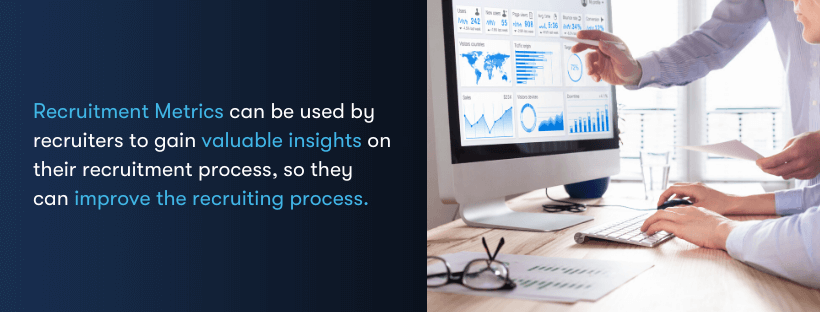Understanding which recruitment strategies are working and which need to be adjusted is vital to lead an effective recruitment process. The truth is recruiters can no longer rely on their intuition to make a fair and objective evaluation of their hiring. Today, it is fairly easy to obtain business data and recruitment professionals must start leveraging recruitment metrics to obtain key information to support their decision making.
A data-driven approach to recruitment offers undeniable benefits. Recruitment analytics allow to optimise the recruiting process, improve the candidate experience, and, ultimately, to consistently and efficiently attract and hire the best talent.
This is such an important recruitment topic that skeeled recently hosted a webinar dedicated to it: “A Matter of Metrics – Measuring Recruitment Success”. We invite you to view the recording as it is full of valuable insights and tips:
How to set the Right Recruitment Metrics
Recruitment metrics are a standard set of measurements used to manage and improve the hiring process. In general, these metrics can be used by recruiters to gain valuable insights on their recruitment process, so they can improve the recruiting workflow and overall process.
Although there’s a wide range of metrics available to track the recruiting process, there's no one-size-fits-all approach to measuring recruitment success.
The best hiring key performance indicators (KPIs) change from company to company, depending on their specific recruitment goals. This means that before setting the KPIs for their recruiting process, recruiters need to define what success means to them and set clear objectives.
Nevertheless, there are 5 recruiting metrics that every recruiter should be tracking and we’ll break them down to you on today’s article.
5 Recruiting Metrics to Assess Your Recruitment’s Effectiveness
Consistently monitoring and analysing the next recruitment KPIs can help recruiters yield significant improvements to their recruitment processes.
1 - Time to hire
Time to hire let’s you know the number of days between the start of the recruitment process and the moment a candidate gets hired. This metric is all about tracking the speed with which good candidates move within your hiring process once they’ve applied, allowing to analyse a recruiting team’s performance.
Improving this metric means reducing the time it takes to fill a position. Considering most talented people are off the market in 10 days, it also means a shorter process gives you a better chance at attracting and hiring top talent.
The best way to optimise your time to hire is to break down your hiring process and measure how much time it took to move candidates from one stage to another. Identifying exactly where your hiring team is spending too much time or energy will allow you to take action.
2 - Cost Per Hire
The cost per hire is a central topic when it comes to calculating and managing the recruitment budget. This metric lets you know what is the average amount of money your company spends to make a new hire. It includes all costs related to recruitment, purchase of equipment, onboarding, administrative costs and benefits. And it can vary depending on variables like the company’s size, the seniority of the position, the number of recruitment channels used.
To calculate the cost per hire you need to sum all internal and external recruiting costs and divide them by the total number of hires. Internal recruiting costs include all costs related to the recruitment department, such as recruiter salaries, interviews, fixed costs related to infrastructures, and employee referral program, etc. The external recruiting costs include all expenses related to external vendors and candidates, namely agency fees, advertising, technology, job fairs, travel costs, relocation costs, signing bonuses, etc.
There are many strategies you can use to reduce your cost per hire and optimise the recruitment process such as building a talent pipeline; allowing employee referrals; using social media to create a strong employer brand, and using an ATS to streamline and expedite your recruitment process.

3 - Qualified Candidates Per Opening
A “qualified candidate” is anyone who passes the application screening process and moves to the next stages of the recruitment process. This KPI is more meaningful than the number of applicants because it shows recruiters how good are the candidates they’re attracting.
It’s really important to measure this metric because if a company realises that they are attracting a lot of unfitted candidates, making it difficult to fill a position, it gives them the opportunity to set new strategies to get better candidates on their funnel.
To calculate the qualified candidates per opening you simply need to divide the number of candidates selected for an interview by the number of candidates presented to the hiring manager.
To get more qualified candidates to apply to your company you must review your sourcing and advertising methods. Ensure you understand the roles you’re hiring for and define the right job requirements, write effective job descriptions, expand your search for passive candidates to different social networks, and invest more in the most effective source channels.
4 - Sourcing Channel Effectiveness
This metric refers to the performance of the different channels like job boards or social media platforms that you use to advertise your job openings, allowing you to verify which channels are working and which ones need to be reconsidered.
Given that there are hundreds of options for sourcing candidates, it’s important to test them and find out which ones are more effective. Once you know which sources provide the greatest number of candidates, you can start looking at which sources produce the best quality candidates over time.
In fact, understanding the most effective source of talent for your organisation ensures the best ROI on time and investment spent on recruiting.
To calculate this metric, candidates need to be tagged according to the acquisition source when they submit their application or to where the recruiter found the profile (LinkedIn, Employee referral, Internal, Facebook, Indeed etc).
To gather this data you need first to determine how you want to categorise your sources (e.g. social media vs Facebook, LinkedIn, Twitter, etc.) and then how will you identify those sources. You can use a survey to inquire your candidates about the application process, including where did they find the job opening or implement an applicant tracking system that will record the source a candidate entered your pipeline from, for example.
5 - Quality of Hire
Quality of hire is at the top of the list of useful performance KPIs for most companies as it measures the value new hires bring to a company. Hiring quality employees means less turnover, more productivity, better culture, and greater overall success for the company. By continuously measuring the quality of hire, you can keep a pulse on the health of your employee base.
As quality is quite hard to evaluate, some quantifiable recruitment metrics can be used instead, such as new hire performance metrics (e.g. meeting X sales quota, delivering Y number of product units or achieving Z customer satisfaction ratings), turnover and retention metrics, hiring manager satisfaction ratings, the percentage of new hires who were promoted within a certain time period, etc.
Improving the quality of hire requires alignment with leadership to define the factors that make a quality hire at your company and to set the strategies that will help you hire the right people.
To help you navigate the many recruiting metrics available, we’ve prepared a printable cheat sheet with 12 top metrics. You can use it to learn how to choose which metrics you want to use to measure your hiring success and to learn how to calculate them. You can download here:
How to Enable a Data-Driven Recruitment Process
As said before, it's important for recruiters to assess in the context of their company’s business which recruitment metrics offer the most important insights. Apart from that, another important thing is to determine how the data for those metrics will be gathered and presented to them.
Using an Applicant Tracking System (ATS) with integrated analytics is a winning option as it can automate your KPIs, making them easily accessible to you to track your hiring success.
Moreover, the right ATS can centralise and standardise your recruitment process and workflows. It supports easy communication between candidates, recruiters and hiring teams. It can reduce the time you spend on administrative tasks as it helps post jobs to multiple job boards in just a few clicks. It can save you time and money when with your hiring and help you get top talent, faster.

Skeeled offers you the perfect opportunity to bring innovation and digitalisation to your hiring. Check our website or our LinkedIn, Twitter and Facebook pages for further information.
Thanks for reading and see you next time!
Your team here at skeeled






